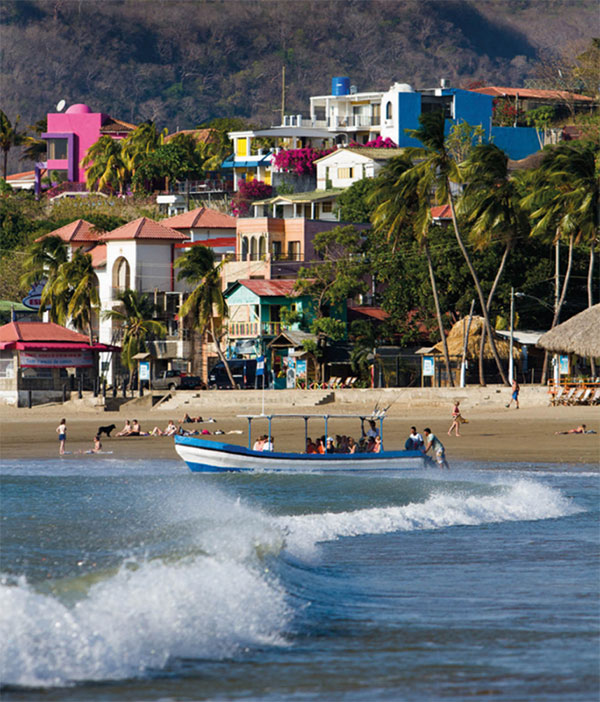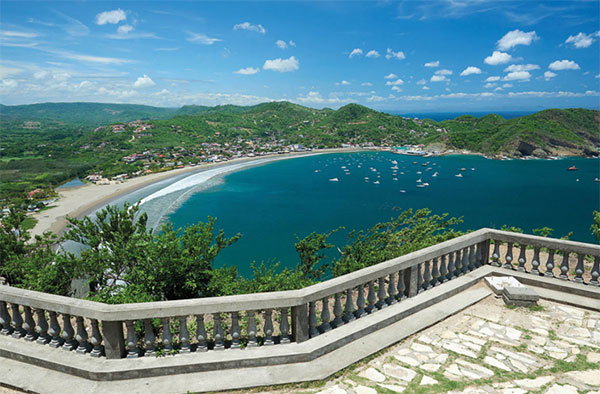CONTINENT CROSSING
During the California gold rush, thousands of would-be prospectors from the east coast of the United States travelled by ship to Nicaragua, where they were able to cross the country via the San Juan River to Lake Nicaragua and then overland to the Pacific, where they could catch a ship up to the north. This route was established by businessman Commodore Cornelius Vanderbilt in the 1850s. Around this time, one famous American traveler who crossed Nicaragua en route to New York from California was the writer Mark Twain who published a series of dispatches about his adventure in San Francisco’s newspaper, the Alta California. Twain’s 1866 journey has since been immortalized in his posthumously published book Travels With Mr. Brown.
San Juan del Sur
A little more than a couple of decades ago, word started to get out about a sleepy fishing village with great surf breaks called San Juan del Sur * [map] . The surfers came, then the backpackers, and then the wealthy Nicaraguans and North American retirees, looking to take advantage of the inexpensive beachfront real estate, snapping up whatever they could. Prices have since ballooned, both to the pleasure and dismay of locals. Some found themselves getting rich, while others were priced out of their once-tranquil neighborhoods. Local anger reached a boiling point in 2006 when an American realtor was convicted of murdering his Nicaraguan ex-girlfriend and sentenced to 30-years in prison. The verdict was overturned a year later after it was proved to be a miscarriage of justice, but an outraged public had wanted to place blame on the gringos that had been disrupting their community. Things have since calmed down and the development on the beaches surrounding San Juan del Sur has spread up and down the coast.

San Juan del Sur’s beachfront.
Getty Images
San Juan del Sur’s main attraction, the beach, encircles a crescent shaped bay where the San Juan River empties into the Pacific Ocean. Aside from a few beachside restaurants, most amenities are set back from the beach’s southeastern corner, in a seemingly thrown-together grid packed with surf stores, a microbrewery, an artisanal donut shop, taquerias, and dozens of small hostels and hotels. The more upscale resorts, like Pelican Eyes (www.facebook.com/PelicanEyesHotelandResort), with three pools and a day spa, are set back from the bay in the hills above town.
On the southern end of the bay is a lookout point where humpback and occasionally blue whales can be seen from November to April. On the highest hill on the north side of the bay, a 25 meter (82ft) statue of Jesus, Cristo de la Misericordia, can be reached on a one-hour hike from the beach, giving spectacular views of the bay.

The view from the Cristo de la Misericordia of San Juan del Sur bay.
Shutterstock
Beaches outside of San Juan del Sur
While San Juan del Sur is the hub of activity along the Pacific, its beach is only so-so. Small coves hidden within the dry hills to the north and south of town have more attractive sand, better waves, and are seeing a speedy influx of new resort communities. Reached by water taxi or along a bumpy, partially paved road from Highway 72 north of San Juan del Sur, Playa Marsella is one of the most accessible good beaches from the town. The road comes right up to the beach and there are a few simple restaurants and guesthouses within a short walk of the waterfront.
A couple of kilometers north is Playa Madera, with a long white sand beach that is popular with both surfers and sunbathers. Clustered in the jungle-clad hills above the beach are a mix of budget surf hostels and upscale hotels like Hulakai (www.hulakaihotel.com) and the Buena Vista Surf Club (www.buenavistasurfclub.com). At Playa Ocotal, where the beach road ends, is the luxe Morgan’s Rock Hacienda and Ecolodge (www.morgansrock.com), set on a 4,000-acre private reserve.
The beaches south of San Juan del Sur are less developed, though no less spectacular. The first good beach is Playa Remanso, which is home to a gated vacation home community and a few palapa (open-sided structure with thatched roof) restaurants on the sand. Playa Hermosa, 20-minutes south, is where the US competitive reality television show Survivor once filmed a season. It has a long white beach popular with surfers and there’s little development, other than the solar powered Playa Hermosa Ecolodge (tel: 07824 6984). The Refugio de Vida Silvestre La Flor, 20km (12 miles) south of San Juan del Sur, is an important nesting area for Olive Ridleys, as well as hawksbill, leatherback, and green turtles. They arrive en masse from July to January and groups come nightly from San Juan del Sur to protect the eggs.
Tola and beaches
Looking for a more authentic scene than the cookie cutter communities being built around San Juan del Sur, developers started carving out the even more dramatic, 30km (18 miles) stretch of coastline west of the tiny town of Tola ( [map] . The town, located between Rivas and the coast, is little more than a service hub with a shady central plaza and a smattering of stores. The Costa Esmeralda airport, which opened close to the beach in 2016, offers direct flights from Managua with the Nicaraguan La Costeña airlines, as well as from Liberia in Costa Rica with Sansa Airlines.
The southernmost of Tola’s beaches is the private Playa Manzanillo, where Guacalito de la Isla, a 1670-acre (675-hectare) luxury resort community, is located. Owned by the billionaire Pellas family, who also own Flor de Caña rum and Toña beer, the Mukul hotel (www.mukulresort.com) offer Nicaragua’s most luxurious accommodations, with a David McLay Kidd signature oceanfront 18-hole golf course, full service spa, and rooms with private plunge pools.
Next is Playa Redonda, home of the luxe Aqua Wellness Resort (www.aquanicaragua.com). More accessible to the public is Playa Gigante, a popular beach with weekenders from Rivas, only an hour away. Backed by thick jungle, the crescent-shaped beach has a few seafood restaurants and small hotels. Fishing boats bob in the bay, while world-class breaks attract a steady stream of surfers.